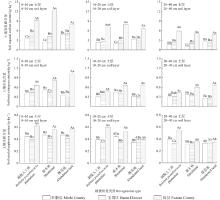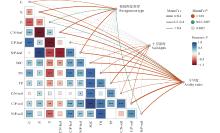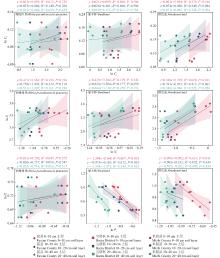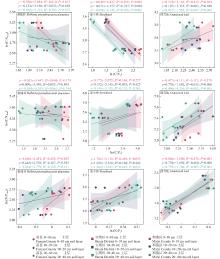

林业科学 ›› 2025, Vol. 61 ›› Issue (6): 61-74.doi: 10.11707/j.1001-7488.LYKX20240365
张城伟1,王兴2,3,安可4,吴子昊1,张静宜5,6,钟泽坤5,*( )
)
收稿日期:2024-06-17
出版日期:2025-06-10
发布日期:2025-06-26
通讯作者:
钟泽坤
E-mail:zhongzekun94@gmail.com
基金资助:
Chengwei Zhang1,Xing Wang2,3,Ke An4,Zihao Wu1,Jingyi Zhang5,6,Zekun Zhong5,*( )
)
Received:2024-06-17
Online:2025-06-10
Published:2025-06-26
Contact:
Zekun Zhong
E-mail:zhongzekun94@gmail.com
摘要:
目的: 分析黄土丘陵区不同干旱区域典型退耕植被叶片-土壤生态化学计量特征与植物内稳态差异,从植物养分利用策略和稳态维持能力的角度确定适宜不同干旱水平的植被恢复类型;并通过解析不同干旱区域典型退耕植被生态化学计量特征与植物内稳态差异驱动的养分循环过程,为黄土丘陵区植被优化调整和土壤养分管理提供科学依据。方法: 沿黄土高原由南向北的干旱梯度,在富县(干旱度0.641)、宝塔区(干旱度0.718)和米脂县(干旱度0.764)选取17年生刺槐人工林、灌木林和撂荒地,分析其叶片和土壤碳(C)、氮(N)、磷(P)含量及化学计量特征,解析各组分的耦合关系并量化叶片内稳态特征。结果: 1)刺槐人工林叶片碳、氮含量分别低于和高于其他植被恢复类型,撂荒地叶片磷含量和碳氮比最高,而灌木林叶片碳磷比、氮磷比最高;撂荒地土壤碳含量、碳氮比和碳磷比总体上高于其他植被恢复类型,刺槐人工林土壤氮含量和氮磷比最低,但其土壤磷含量显著高于灌木林和撂荒地。2)随干旱度增加,宝塔区叶片碳和氮含量分别较富县降低了8.77%和6.64%,而磷含量则增加了34.25%;米脂县叶片碳和氮含量分别较富县降低了1.01%和44.53%,而磷含量则增加了16.02%;随干旱度增加,叶片碳磷比和氮磷比变化趋势分别与碳、氮相同,分别呈先降后增和降低趋势;而碳氮比则呈升高趋势。3)土壤碳含量(富县、宝塔区、米脂县平均值分别为7.47、3.44和2.67 g·kg?1,下同)、氮含量(平均值分别为0.66、0.36和0.37 g·kg?1)及碳氮比(平均值分别为11.62、9.62和7.59)、碳磷比(平均值分别为14.89、9.25和6.64)和氮磷比(平均值分别为1.37、0.99和0.92)随干旱度增加均呈降低趋势,土壤磷含量(平均值分别为0.50、0.36和0.40 g·kg?1)则呈先降后增趋势。4)干旱度增加和撂荒地向林地的转变分别加剧植被生长受氮限制和磷限制的程度;Mantel分析显示,叶片和土壤碳、氮、磷含量及其化学计量之间均存在不同水平的显著相关关系,干旱度较植被类型和土层深度对叶片和土壤指标的影响更高。5)不同退耕植被维持叶片化学计量内稳态的能力存在明显差异;各植被类型叶片碳均属绝对稳态型,撂荒地和灌木林叶片氮、磷呈现出弱稳态或敏感型特征,且撂荒地叶片碳磷比表现为敏感态或弱稳态,刺槐及灌木叶片碳氮比、氮磷比呈现出敏感型特征。结论: 干旱度是调控退耕植被叶片-土壤碳、氮、磷化学计量特征的关键环境因子;刺槐人工林在黄土丘陵区不同干旱区能更有效地维持叶片内稳性以适应不同干旱度下土壤碳、氮、磷及其化学计量变异,其适应能力强于灌木林和撂荒地,可作为该区域植被恢复与重建的主要树种;在干旱度较高的区域以及撂荒地应补充氮肥,而相对湿润的灌木林和乔木林应增施氮、磷肥。
中图分类号:
张城伟,王兴,安可,吴子昊,张静宜,钟泽坤. 黄土丘陵区退耕植被叶片-土壤生态化学计量特征与植物内稳态差异[J]. 林业科学, 2025, 61(6): 61-74.
Chengwei Zhang,Xing Wang,Ke An,Zihao Wu,Jingyi Zhang,Zekun Zhong. Leaf-Soil Ecological Stoichiometric Characteristics and Plant Homeostasis Differences of Reclaimed Vegetation in the Loess Hilly Region[J]. Scientia Silvae Sinicae, 2025, 61(6): 61-74.
表1
样地基本信息"
| 研究区域 Study area | 植被类型 Revegetation type | 纬度 Latitude(N) | 经度 Longitude(E) | 海拔 Altitude/m | 坡度 Slope/(°) | 降雨量 Rainfall/mm | 蒸散量 Evaporation/ mm | 年均温 Annual temperature/℃ |
| 米脂县 Mizhi County | 刺槐人工林 Robinia pseudoacacia plantation | 37°45′37″ | 110°15′42″ | 1 056.0 | 15 | 418.1 | 1 771.5 | 8.5 |
| 灌木林 Shrubland | 37°51′33″ | 110°10′30″ | 1 088.0 | 25 | 418.1 | 1 771.5 | 8.5 | |
| 撂荒地 Abandoned land | 37°48′43″ | 110°10′41″ | 1 013.0 | 0 | 418.1 | 1 771.5 | 8.5 | |
| 宝塔区 Baota District | 刺槐人工林 Robinia pseudoacacia plantation | 36°39′17″ | 109°21′12″ | 1 262.5 | 25 | 456.1 | 1 618.2 | 9.9 |
| 灌木林 Shrubland | 36°39′33″ | 109°21′06″ | 1 262.0 | 23 | 456.1 | 1 618.2 | 9.9 | |
| 撂荒地 Abandoned land | 36°18′25″ | 109°20′47″ | 1 190.2 | 15 | 456.1 | 1 618.2 | 9.9 | |
| 富县 Fuxian County | 刺槐人工林 Robinia pseudoacaciaplantation | 35°05′35″ | 109°40′11″ | 1 201.6 | 14 | 532.7 | 1 484.1 | 9.5 |
| 灌木林 Shrubland | 35°13′34″ | 109°37′21″ | 1 288.6 | 0 | 532.7 | 1 484.1 | 9.5 | |
| 撂荒地 Abandoned land | 35°06′05″ | 109°35′14″ | 1 103.3 | 0 | 532.7 | 1 484.1 | 9.5 |
表2
不同干旱度下各植被恢复类型叶片碳、氮、磷含量及其化学计量特征①"
| 研究区域 Study area | 干旱度 Aridity index | 植被类型 Revegetation type | 叶片碳含量 Leaf carbon content/ (g·kg?1) | 叶片氮含量 Leaf nitrogen content/ (g·kg?1) | 叶片磷含量 Leaf phosphorus content/ (g·kg?1) | 叶片碳氮比 Leaf carbon to nitrogen ratio | 叶片碳磷比 Leaf carbon to phosphorus ratio | 叶片氮磷比 Leaf nitrogen to phosphorus ratio |
| 米脂县 Mizhi County | 0.764 | 刺槐人工林 Robinia pseudoacacia plantation | 447.42±10.93Ab | 18.18±0.90Ba | 2.05±0.05Ab | 24.70±1.02Ac | 218.32±1.29Ab | 8.88±0.43Ca |
| 灌木林 Shrubland | 475.40±5.36Aa | 14.68±0.45Cb | 1.92±0.06Bb | 32.43±0.81Ab | 248.65±7.49Ba | 7.66±0.07Cb | ||
| 撂荒地 Abandoned land | 467.01±4.96Aab | 9.52±0.27Cc | 2.33±0.12Ba | 49.17±1.75Aa | 201.54±12.75Bb | 4.09±0.13Bc | ||
| 宝塔区 Baota District | 0.718 | 刺槐人工林 Robinia pseudoacacia plantation | 417.87±6.81Bb | 31.00±0.89Aa | 2.02±0.04Ac | 13.50±0.44Bb | 206.77±7.24Aa | 15.33±0.45Aa |
| 灌木林 Shrubland | 427.78±3.88Bab | 26.93±0.66Bb | 2.51±0.02Ab | 15.90±0.24Bb | 170.69±2.42Cb | 10.75±0.31Bb | ||
| 撂荒地 Abandoned land | 435.16±1.41Ba | 13.41±0.90Bc | 2.76±0.09Aa | 32.73±2.09Ba | 158.04±5.51Bb | 4.85±0.22Bc | ||
| 富县 Fuxian County | 0.641 | 刺槐人工林 Robinia pseudoacacia plantation | 449.68±5.27Ab | 28.94±0.11Aa | 2.06±0.02Aa | 15.54±0.13Bb | 218.07±4.21Ac | 14.03±0.16Bb |
| 灌木林 Shrubland | 480.07±5.85Aa | 31.04±0.88Aa | 1.52±0.01Cb | 15.49±0.50Bb | 315.89±3.27Aa | 20.44±0.70Aa | ||
| 撂荒地 Abandoned land | 474.21±2.92Aa | 16.42±0.72Ab | 1.86±0.12Ca | 28.98±1.12Ba | 257.68±17.85Ab | 8.95±0.84Ac |

图1
不同干旱度下各植被恢复类型土壤碳、氮、磷含量 相同干旱度下不同植被类型之间不同小写字母表示差异显著,相同植被类型下不同干旱度之间不同大写字母表示差异显著(P<0.05)。Lowercase letters indicate significant differences between different vegetation types under the same aridity level, while uppercase letters indicate significant differences between different aridity levels for the same vegetation type (P<0.05)."


图3
叶片和土壤碳、氮、磷含量及其化学计量及环境因子的关系分析 蓝色和红色填充深度分别表示正相关和负相关关系的强弱,线条颜色和粗细分别表示基于Mantel’s P值和Mantel’s r值的相关性大小。The color gradient representing Pearson’ s correlation coefficient. The color and thickness of the lines represent the magnitude of correlation based on the Mantel’s P value and Mantel’s r value, respectively. Cl:叶片碳含量Leaf carbon content;Nl:叶片氮含量 Leaf nitrogen content;Pl:叶片磷含量 Leaf phosphorus content;C:N-leaf:叶片碳氮比 Leaf carbon to nitrogen ratio;C:P-leaf:叶片碳磷比 Leaf carbon to phosphorus ratio;N:P-leaf:叶片氮磷比 Leaf nitrogen to phosphorus ratio;SOC:土壤有机碳含量 Soil organic carbon content;TN:土壤全氮含量 Soil total nitrogen content;TP:土壤全磷含量 Soil total phosphorus content;C:N-soil:土壤碳氮比 Soil carbon to nitrogen ratio;C:P-soil:土壤碳磷比 Soil carbon to phosphorus ratio;N:P-soil:土壤氮磷比 Soil nitrogen to phosphorus ratio. *: P<0.05;**: P<0.01;***: P<0.001."


图4
不同植被恢复类型叶片碳、氮、磷内稳态特征 红色、蓝色、绿色的公式及直线分别代表0~10、10~20和20~40 cm土层土壤全碳含量、全氮含量或全磷含量与叶片碳、氮、磷含量之间的拟合关系。The formulas and lines in red, blue, and green represent the fitting relationships between soil total carbon, total nitrogen, or total phosphorus content in the 0–10, 10–20, and 20–40 cm soil layers and leaf carbon, nitrogen, and phosphorus content, respectively. Cl:叶片碳含量 Leaf carbon content;Nl:叶片氮含量 Leaf nitrogen content;Pl:叶片磷含量 Leaf phosphorus content;CS:土壤有机碳含量 Soil organic carbon content;NS:土壤全氮含量 Soil total nitrogen content;、PS:土壤全磷含量 Soil total phosphorus content."


图5
不同植被恢复类型叶片碳、氮、磷化学计量内稳态特征 红色、蓝色、绿色的公式及直线分别代表0~10、10~20和20~40 cm土层土壤化学计量比与叶片化学计量比之间的拟合关系。The formulas and lines in red, blue, and green respectively represent the fitting relationships between soil stoichiometric ratios in the 0–10, 10–20, and 20–40 cm soil layers and leaf stoichiometric ratios, respectively. C:N-leaf:叶片碳氮比 Leaf carbon to nitrogen ratio;C:P-leaf:叶片碳磷比 Leaf carbon to phosphorus ratio;N:P-leaf:叶片氮磷比 Leaf nitrogen to phosphorus ratio;C:Ns:土壤碳氮比 Soil carbon to nitrogen ratio;C:Ps:土壤碳磷比 Soil carbon to phosphorus ratio;N:Ps:土壤氮磷比 Soil nitrogen to phosphorus ratio;"

|
白建军, 史清亮. 柠条与沙棘共生固氮菌资源特性对比分析. 山西农业科学, 2008, (9): 49- 52.
doi: 10.3969/j.issn.1002-2481.2008.09.014 |
|
|
Bai J J, Shi Q L. A comparative analysis on resources characteristics of symbiotic nitrogen fixation strains of Peashrub and Hippophae. Journal of Shanxi Agricultural Sciences, 2008, (9): 49- 52.
doi: 10.3969/j.issn.1002-2481.2008.09.014 |
|
| 鲍士旦. 2000. 土壤农化分析. 北京: 中国农业出版社. | |
| Bao S D. 2000. Soil agricultural chemistry analysis. Beijing: China Agricultural Press. [in Chinese] | |
| 陈雅涵, 谢宗强. 保存过程对土壤生化指标的影响及保存土样的应用. 土壤学报, 2018, 55 (4): 783- 796. | |
| Chen Y H, Xie Z Q. Effects of storage on soil biochemical properties and application of stored soil. Acta Pedologica Sinica, 2018, 55 (4): 783- 796. | |
| 邓 健, 张 丹, 张 伟, 等. 黄土丘陵区刺槐叶片-土壤-微生物碳氮磷化学计量学及其稳态性特征. 生态学报, 2019, 39 (15): 5527- 5535. | |
| Deng J, Zhang D, Zhang W, et al. Carbon, nitrogen, and phosphorus stoichiometry and homeostasis characteristics of leaves, soil, and microbial biomass of Robinia pseudoacacia forests in the Loess Hilly Region of China. Acta Ecologica Sinica, 2019, 39 (15): 5527- 5535. | |
| 邓 强, 李 婷, 袁志友, 等. 黄土高原4种植被类型的细根生物量和年生产量. 应用生态学报, 2014, 25 (11): 3091- 3098. | |
| Deng Q, Li T, Yuan Z Y et al. Fine root biomass and production of four vegetation types in Loess Plateau, China. Chinese Journal of Applied Ecology, 2014, 25 (11): 3091- 3098. | |
|
高子滢, 王海燕, 张亦凡. 土壤碳氮磷化学计量特征及其驱动因素. 浙江农林大学学报, 2024, 42 (3): 645- 656.
doi: 10.11833/j.issn.2095-0756.20240564 |
|
|
Gao Z Y, Wang H Y, Zhang Y F. Soil carbon, nitrogen and phosphorus stoichiometric characteristics and driving factors: a review. Journal of Zhejiang A& F University, 2024, 42 (3): 645- 656.
doi: 10.11833/j.issn.2095-0756.20240564 |
|
| 何茂松, 罗 艳, 彭庆文, 等. 新疆67种荒漠植物叶碳氮磷计量特征及其与气候的关系. 应用生态学报, 2019, 30 (7): 2171- 2180. | |
| He M S, Luo Y, Peng Q W, et al. Leaf C: N: P stoichiometry of 67 plant species and its relations with climate factors across the deserts in Xinjiang, China. Chinese Journal of Applied Ecology, 2019, 30 (7): 2171- 2180. | |
|
李冬冬, 方 昭, 杜好田, 等. 黄土高原不同植被带草本植物叶片与土壤碳氮分布特征. 植物营养与肥料学报, 2019, 25 (5): 841- 850.
doi: 10.11674/zwyf.18141 |
|
|
Li D D, Fang Z, Du H T, et al. Distribution characteristics of carbon and nitrogen in herbaceous plants leaves and soil of different vegetation belts in the Loess Plateau. Journal of Plant Nutrition and Fertilizer, 2019, 25 (5): 841- 850.
doi: 10.11674/zwyf.18141 |
|
|
李明雨, 黄文广, 杨君珑, 等. 宁夏草原植物叶片氮磷化学计量特征及其驱动因素. 草业学报, 2019, 28 (2): 23- 32.
doi: 10.11686/cyxb2018459 |
|
|
Li M Y, Huang W G, Yang J L, et al. Factors influencing leaf nitrogen and phosphorus stoichiometry in plant species of Ningxia grasslands. Acta Prataculturae Sinica, 2019, 28 (2): 23- 32.
doi: 10.11686/cyxb2018459 |
|
| 李铭怡, 王 冉, 贾濠基, 等. 干旱胁迫下油菜素内酯对植物-土壤化学计量特征及内稳性的影响. 草地学报, 2024, 32 (4): 1068- 1077. | |
| Li M Y, Wang R, Jia H J, et al. Effects of brassinosteroid on plant-soil stoichiometric characteristics and homeostasis under drought stress. Acta Agrestia Sinica, 2024, 32 (4): 1068- 1077. | |
|
李平平, 王彦辉, 段文标, 等. 黄土高原刺槐人工林立地指数变化及评价. 林业科学, 2023, 59 (4): 18- 31.
doi: 10.11707/j.1001-7488.LYKX20220621 |
|
|
Li P P, Wang Y H, Duan W B, et al. Variation and evaluation of site index of black locust plantations on the Loess Plateau of Northwest China. Scientia Silvae Sinicae, 2023, 59 (4): 18- 31.
doi: 10.11707/j.1001-7488.LYKX20220621 |
|
|
刘兴良, 肖 林, 宿以明, 等. 川西云杉人工林养分含量、贮量及分配的研究. 林业科学, 2001, 37 (4): 10- 18.
doi: 10.3321/j.issn:1001-7488.2001.04.003 |
|
|
Liu X L, Xiao L, Su Y M, et al. Concentration, storage and allocation of nutrient element in Picea balfourlana plantation of west Sichuan. Scientia Silvae Sinicae, 2001, 37 (4): 10- 18.
doi: 10.3321/j.issn:1001-7488.2001.04.003 |
|
| 李欣阳, 张娟娟, 周建云, 等. 宁南山区人工混交林叶片-凋落物-细根生态化学计量特征. 应用生态学报, 2023, 34 (11): 2889- 2897. | |
| Li X Y, Zhang J J, Zhou J Y, et al. Ecological stoichiometry of leaf-litter-fine roots in mixed plantations in mountainous area of Southern Ningxia, China. Chinese Journal of Applied Ecology, 2023, 34 (11): 2889- 2897. | |
| 刘玉林, 朱广宇, 邓 蕾, 等. 黄土高原植被自然恢复和人工造林对土壤碳氮储量的影响. 应用生态学报, 2018, 29 (7): 2163- 2172. | |
| Liu Y L, Zhu G Y, Deng L, et al. Effects of natural vegetation restoration and afforestation on soil carbon and nitrogen storage in the Loess Plateau, China. Chinese Journal of Applied Ecology, 2018, 29 (7): 2163- 2172. | |
| 刘亚楠, 陈晓娜, 郭 跃, 等. 沙旱生灌木对干旱胁迫的响应研究进展. 世界林业研究, 2023, 36 (5): 21- 26. | |
| Liu Y N, Chen X N, Guo Y, et al. Research progress in response of sandy xerophytic shrubs to drought stress. World Forestry Research, 2023, 36 (5): 21- 26. | |
| 鲁如坤. 2000. 土壤农业化学分析方法. 北京: 中国农业科技出版社. | |
| Lu R K. 2000. Analytical methods for soil and agro-chemistry. Beijing: China Agricultural Science and Technology Press. [in Chinese] | |
| 苏卓侠, 苏冰倩, 上官周平. 2020. 黄土高原刺槐叶片-土壤生态化学计量参数对降雨量的响应特征. 生态学报, 40(19): 7000–7008. | |
| Su Z X, Su B Q, Shangguan Z P. 2020. Response characteristics of Robinia pseudoacacia leaf and soil ecological stoichiometric parameters to precipitation in the Loess Plateau. Acta Ecologica Sinica, 40(19): 7000–7008. [in Chinese] | |
|
王绍强, 于贵瑞. 生态系统碳氮磷元素的生态化学计量学特征. 生态学报, 2008, 28 (8): 3937- 3947.
doi: 10.3321/j.issn:1000-0933.2008.08.054 |
|
|
Wang S Q, Yu G R. Ecological stoichiometry characteristics of ecosystem carbon, nitrogen and phosphorus elements. Acta Ecologica Sinica, 2008, 28 (8): 3937- 3947.
doi: 10.3321/j.issn:1000-0933.2008.08.054 |
|
| 王 稳, 高晓东, 赵西宁, 等. 黄土高原不同气候区刺槐林恢复年限对水、碳及植物多样性的影响. 生态学报, 2023, 43 (23): 9770- 9783. | |
| Wang W, Gao X D, Zhao X N, et al. Effects of returning years of Robinia pseudoacacia forest on water, carbon and plant diversity in different climatic regions of the Loess Plateau. Acta Ecologica Sinica, 2023, 43 (23): 9770- 9783. | |
|
邢 伟, 刘 寒, 刘贵华. 生态化学计量学在水生态系统中的研究与应用. 植物科学学报, 2015, 33 (5): 608- 619.
doi: 10.11913/PSJ.2095-0837.2015.50608 |
|
|
Xing W, Liu H, Liu G H. Ecological stoichiometry in aquatic ecosystems: studies and applications. Plant Science Journal, 2015, 33 (5): 608- 619.
doi: 10.11913/PSJ.2095-0837.2015.50608 |
|
| 许淼平, 张欣怡, 李文杰, 等. 不同林龄刺槐叶片养分重吸收特征及其对土壤养分有效性的响应. 应用生态学报, 2020, 31 (10): 3357- 3364. | |
| Xu M P, Zhang X Y, Li W J, et al. Leaf nutrient resorption characteristics of Robinia pseudoacacia at different ages and their response to soil nutrient availability. Chinese Journal of Applied Ecology, 2020, 31 (10): 3357- 3364. | |
| 薛智超, 甄 霖, 闫慧敏. 基于土地多功能的黄土丘陵沟壑区生态保护与发展情景评估及多主体模拟. 生态学报, 2023, 43 (15): 6081- 6098. | |
| Xue Z C, Zhen L, Yan H M. The scenario assessment of ecological protection and development in the Loess Hilly and Gully area based on land use functions and agent based modelling. Acta Ecologica Sinica, 2023, 43 (15): 6081- 6098. | |
| 尹嘉德, 侯慧芝, 张绪成, 等. 全膜覆土下施有机肥对春小麦旗叶碳氮比、光合特性和产量的影响. 应用生态学报, 2020, 31 (11): 3749- 3757. | |
| Yin J D, Hou H Z, Zhang X C, et al. Effects of organic fertilizer application on flag leaf C/N ratio, photosynthetic characteristics and yield of spring wheat with full plastic film mulching. Chinese Journal of Applied Ecology, 2020, 31 (11): 3749- 3757. | |
|
詹紫馨, 冯天骄, 梅柏寒, 等. 晋西黄土区典型植被恢复生态系统各层次化学计量与生态因子的关系. 浙江农林大学学报, 2024, 41 (4): 797- 809.
doi: 10.11833/j.issn.2095-0756.20230448 |
|
|
Zhan Z X, Feng T J, Mei B H, et al. Relationship between stoichiometry and ecological factors at various levels of typical vegetation restoration ecosystem in the loess area of western Shanxi Province. Journal of Zhejiang A& F University, 2024, 41 (4): 797- 809.
doi: 10.11833/j.issn.2095-0756.20230448 |
|
|
张婷婷, 刘文耀, 黄俊彪, 等. 植物生态化学计量内稳性特征. 广西植物, 2019, 39 (5): 701- 712.
doi: 10.11931/guihaia.gxzw201805050 |
|
|
Zhang T T, Liu W Y, Huang J B, et al. Characteristics of plant ecological stoichiometry homeostasis. Guihaia, 2019, 39 (5): 701- 712.
doi: 10.11931/guihaia.gxzw201805050 |
|
| 曾小红, 马焕成, 伍建榕, 等. 根瘤菌的抗旱性研究进展. 西南林学院学报, 2005, 25 (3): 80- 83. | |
| Zeng X H, Ma H C, Wu J R, et al. Research advances in drought-resistance of rhizobium. Journal of Southwest Forestry College, 2005, 25 (3): 80- 83. | |
| 张 勇, 吴翠蓉, 高海力, 等. 香榧幼龄林叶片与土壤碳氮磷的生态化学计量特征. 中南林业科技大学学报, 2022, 42 (1): 104- 110,119. | |
| Zhang Y, Wu C R, Gao H L, et al. The stoichiometric characteristics of carbon, nitrogen and phosphorous in soil and leaves of Torreya grandis at different ages. Journal of Central South University of Forestry & Technology, 2022, 42 (1): 104- 110,119. | |
| 张雨鉴, 王克勤, 宋娅丽, 等. 滇中亚高山5种林型土壤碳氮磷生态化学计量特征. 生态环境学报, 2019, 28 (1): 73- 82. | |
| Zhang Y J, Wang K Q, Song Y L, et al. Ecological stoichiometry of soil carbon, nitrogen and phosphorus in five forest types in subalpine of middle Yunnan Province. Ecology and Environmental Sciences, 2019, 28 (1): 73- 82. | |
| 钟泽坤, 杨改河, 任成杰, 等. 黄土丘陵区撂荒农田土壤酶活性及酶化学计量变化特征. 环境科学, 2021, 42 (1): 411- 421. | |
| Zhong Z K, Yang G H, Ren C J, et al. Effects of farmland abandonment on soil enzymatic activity and enzymatic stoichiometry in the Loess Hilly Region, China. Environmental Science, 2021, 42 (1): 411- 421. | |
|
周正虎, 王传宽. 微生物对分解底物碳氮磷化学计量的响应和调节机制. 植物生态学报, 2016, 40 (6): 620- 630.
doi: 10.17521/cjpe.2015.0449 |
|
|
Zhou Z H, Wang C K. Responses and regulation mechanisms of microbial decomposers to substrate carbon, nitrogen, and phosphorus stoichiometry. Chinese Journal of Plant Ecology, 2016, 40 (6): 620- 630.
doi: 10.17521/cjpe.2015.0449 |
|
|
Bussotti F, Borghini F, Celesti C, et al. Leaf morphology and macronutrients in broadleaved trees in central Italy. Trees, 2000, 14 (7): 361- 368.
doi: 10.1007/s004680000056 |
|
|
Cui Y X, Wang X, Zhang X C, et al. Soil moisture mediates microbial carbon and phosphorus metabolism during vegetation succession in a semiarid region. Soil Biology and Biochemistry, 2020, 147, 107814.
doi: 10.1016/j.soilbio.2020.107814 |
|
| da Silva E C, Nogueira R, da Silva M A, et al. Drought stress and plant nutrition. Plant stress, 2011, 5 (1): 32- 41. | |
|
Elrys A S, El-Maati M F A, Dan X Q, et al. Aridity creates global thresholds in soil nitrogen retention and availability. Global Change Biology, 2024, 30 (1): e17003.
doi: 10.1111/gcb.17003 |
|
|
Elser J J, Fagan W F, Kerkhoff A J, et al. Biological stoichiometry of plant production: metabolism, scaling and ecological response to global change. New Phytologist, 2010, 186 (3): 593- 608.
doi: 10.1111/j.1469-8137.2010.03214.x |
|
|
Elser J J, Urabe J. The stoichiometry of consumer-driven nutrient recycling: theory, observations, and consequences. Ecology, 1999, 80 (3): 735- 751.
doi: 10.1890/0012-9658(1999)080[0735:TSOCDN]2.0.CO;2 |
|
|
Gu Q, Zamin T J, Grogan P. Stoichiometric homeostasis: a test to predict tundra vascular plant species and community-level responses to climate change. Arctic Science, 2017, 3 (2): 320- 333.
doi: 10.1139/as-2016-0032 |
|
|
Hu W G, Ran J Z, Dong L W, et al. Aridity-driven shift in biodiversity-soil multifunctionality relationships. Nature Communications, 2021, 12 (1): 5350.
doi: 10.1038/s41467-021-25641-0 |
|
|
Julian P, Gerber S, Bhomia R K, et al. Understanding stoichiometric mechanisms of nutrient retention in wetland macrophytes: stoichiometric homeostasis along a nutrient gradient in a subtropical wetland. Oecologia, 2020, 193 (4): 969- 980.
doi: 10.1007/s00442-020-04722-9 |
|
|
Koerselman W, Meuleman A F M. The vegetation N: P ratio: a new tool to detect the nature of nutrient limitation. Journal of Applied Ecology, 1996, 33 (6): 1441- 1450.
doi: 10.2307/2404783 |
|
|
Li Y F, Li Q Y, Guo D Y, et al. Ecological stoichiometry homeostasis of Leymus chinensis in degraded grassland in western Jilin Province, NE China. Ecological Engineering, 2016, 90, 387- 391.
doi: 10.1016/j.ecoleng.2016.01.079 |
|
|
Liang H B, Li Y N, An X X, et al. Soil moisture dynamics and its temporal stability under different-aged Caragana korshinskii shrubs in the Loess Hilly Region of China. Water, 2023, 15 (13): 2334.
doi: 10.3390/w15132334 |
|
|
Niklas K J, Owens T, Reich P B, et al. Nitrogen/phosphorus leaf stoichiometry and the scaling of plant growth. Ecology Letters, 2005, 8 (6): 636- 642.
doi: 10.1111/j.1461-0248.2005.00759.x |
|
|
Nobile C M, Bravin M N, Becquer T, et al. Phosphorus sorption and availability in an andosol after a decade of organic or mineral fertilizer applications: importance of pH and organic carbon modifications in soil as compared to phosphorus accumulation. Chemosphere, 2020, 239, 124709.
doi: 10.1016/j.chemosphere.2019.124709 |
|
|
Persson J, Fink P, Goto A, et al. To be or not to be what you eat: regulation of stoichiometric homeostasis among autotrophs and heterotrophs. Oikos, 2010, 119 (5): 741- 751.
doi: 10.1111/j.1600-0706.2009.18545.x |
|
|
Sardans J, Peñuelas J. Hydraulic redistribution by plants and nutrient stoichiometry: shifts under global change. Ecohydrology, 2014, 7 (1): 1- 20.
doi: 10.1002/eco.1459 |
|
| Sardans J, Peñuelas J , Estiarte M, et al. 2008. Warming and drought alter C and N concentration, allocation and accumulation in a Mediterranean shrubland. Global Change Biology, 14(10): 2304–2316. | |
|
Spohn M. Element cycling as driven by stoichiometric homeostasis of soil microorganisms. Basic and Applied Ecology, 2016, 17 (6): 471- 478.
doi: 10.1016/j.baae.2016.05.003 |
|
| Sterner R W, Elser J J. 2002. Ecological stoichiometry: the biology of elements from molecules to the biosphere. Princeton: Princeton University Press. | |
| Su Z X, Su B Q, Mao S L, et al. Leaf C: N: P stoichiometric homeostasis of a Robinia pseudoacacia plantation on the Loess Plateau. Journal of Forestry Research, 2022, 34 (4): 929- 937. | |
|
Wang C Y, Yu M H, Ding G D, et al. Effect of rainfall on Artemisia ordosica Krasch anual net primary production and allocation in sandy land in China. Ecological Indicators, 2021, 130, 108023.
doi: 10.1016/j.ecolind.2021.108023 |
|
|
Yang S B, Feng C, Ma Y H, et al. Transition from N to P limited soil nutrients over time since restoration in degraded subtropical broadleaved mixed forests. Forest Ecology and Management, 2021, 494, 119298.
doi: 10.1016/j.foreco.2021.119298 |
|
|
Yu Q A, Elser J J, He N P, et al. Stoichiometric homeostasis of vascular plants in the Inner Mongolia grassland. Oecologia, 2011, 166 (1): 1- 10.
doi: 10.1007/s00442-010-1902-z |
|
|
Zechmeister-Boltenstern S, Keiblinger K M, Mooshammer M, et al. The application of ecological stoichiometry to plant-microbial-soil organic matter transformations. Ecological Monographs, 2015, 85 (2): 133- 155.
doi: 10.1890/14-0777.1 |
|
|
Zhang H, Li X, Wang S Q, et al. Tree-litter-soil system C: N: P stoichiometry and tree organ homeostasis in mixed and pure Chinese fir stands in south subtropical China. Frontiers in Forests and Global Change, 2024, 7, 1293439.
doi: 10.3389/ffgc.2024.1293439 |
|
|
Zhang S L, Huffman T, Zhang X Y, et al. Spatial distribution of soil nutrient at depth in black soil of Northeast China: a case study of soil available phosphorus and total phosphorus. Journal of soils and sediments, 2014, 14 (11): 1775- 1789.
doi: 10.1007/s11368-014-0935-z |
|
|
Zhang W, Xu Y D, Gao D X, et al. Ecoenzymatic stoichiometry and nutrient dynamics along a revegetation chronosequence in the soils of abandoned land and Robinia pseudoacacia plantation on the Loess Plateau, China. Soil Biology and Biochemistry, 2019, 134, 1- 14.
doi: 10.1016/j.soilbio.2019.03.017 |
|
|
Zhao M, Dai Q H, Zhu L K, et al. Influence of vegetation types on the C, N, and P stoichiometric characteristics of litter and soil and soil enzyme activity in karst ecosystems. Forests, 2023, 14 (4): 771.
doi: 10.3390/f14040771 |
|
|
Zhong Z K, Wu S J, Lu X Q, et al. Organic carbon, nitrogen accumulation, and soil aggregate dynamics as affected by vegetation restoration patterns in the Loess Plateau of China. Catena, 2021, 196, 104867.
doi: 10.1016/j.catena.2020.104867 |
| [1] | 崔妞妞,庞建壮,张祎帆,许行,张勤,张志强. 海河典型流域气候变化和植被恢复对水文的影响——以张家口清水河流域为例[J]. 林业科学, 2025, 61(3): 38-49. |
| [2] | 秦坤蓉,秦华,林立,王海洋. 种子功能性状在道路边坡植物群落形成过程中的作用[J]. 林业科学, 2024, 60(3): 141-149. |
| [3] | 王泽锦, 冉堃, 于淼, 张碧嘉, 冀莉, 李品. 北京市元宝槭和紫丁香叶片的功能性状和生态化学计量比及养分重吸收效率的城乡梯度差异[J]. 林业科学, 2024, 60(2): 42-54. |
| [4] | 王彦辉,于澎涛,田奥,韩新生,郝佳,刘泽彬,王晓. 黄土高原和六盘山区的林水协调多功能管理[J]. 林业科学, 2023, 59(4): 1-17. |
| [5] | 李平平,王彦辉,段文标,王依瑞,于澎涛,甄理,李志鑫,尚会军,史再军,于艺鹏. 黄土高原刺槐人工林立地指数变化及评价[J]. 林业科学, 2023, 59(4): 18-31. |
| [6] | 杨菲,林毅雁,陈立欣,韩璐,吴应明,喻雅洁. 晋西黄土区油松和刺槐2种人工林内乔灌优势种的土壤水分利用及水分生态位特征[J]. 林业科学, 2022, 58(6): 1-12. |
| [7] | 温文杰,王冬梅. 青海黄土高寒区4种典型人工林树木叶片碳氮磷含量及化学计量特征[J]. 林业科学, 2022, 58(1): 22-31. |
| [8] | 王丽红,高鸿坤,赵雨森,付强,何传源,孙鑫,梁建鑫,张啸鹏. 火烧迹地植被恢复对生长季林内小气候的调节作用[J]. 林业科学, 2021, 57(4): 14-23. |
| [9] | 赵瑞,王传宽,全先奎,王兴昌. 黑龙江省帽儿山温带阔叶树种不同器官的生态化学计量特征[J]. 林业科学, 2021, 57(2): 1-11. |
| [10] | 芦琛,蒋小董,吴冠宇,郝爽敬,丁宏博,佟小刚. 黄土丘陵区不同退耕林地表土水溶性有机质含量及光谱特征差异[J]. 林业科学, 2021, 57(11): 13-23. |
| [11] | 王振鹏,陈金磊,李尚益,张仕吉,方晰. 湘中丘陵区不同恢复阶段森林生态系统的碳储量特征[J]. 林业科学, 2020, 56(5): 19-28. |
| [12] | 王安宁, 黄秋娴, 李晓刚, 徐学华, 李玉灵. 冀北山区不同植被恢复类型根际土壤细菌群落结构及多样性[J]. 林业科学, 2019, 55(9): 130-141. |
| [13] | 程瑞梅, 王娜, 肖文发, 沈雅飞, 刘泽彬. 陆地生态系统生态化学计量学研究进展[J]. 林业科学, 2018, 54(7): 130-136. |
| [14] | 李梁, 张建军, 陈宝强, 冯换成, 张守红, 孙若修, 高思远, 张海博, 印家齐. 晋西黄土区长期封禁小流域植被群落动态变化[J]. 林业科学, 2018, 54(2): 1-9. |
| [15] | 王绍飞, 赵西宁, 高晓东, 霍高鹏, 潘燕辉. 黄土丘陵区盛果期苹果树土壤水分利用策略[J]. 林业科学, 2018, 54(10): 31-38. |
| 阅读次数 | ||||||
|
全文 |
|
|||||
|
摘要 |
|
|||||